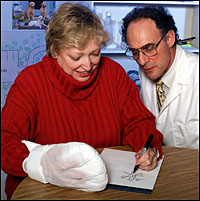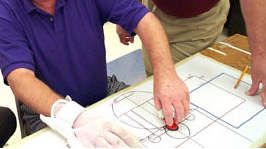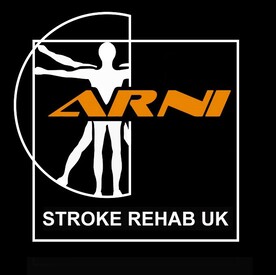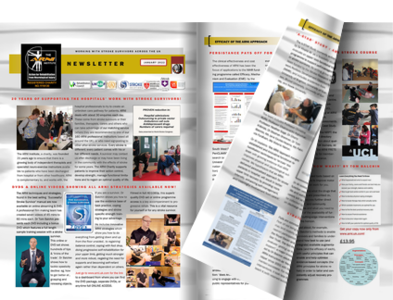Fiona is an instructor based in Cornwall, employed also as an NHS physiotherapist.. She has written an article for readers of the website about Constraint Induced Movement Therapy. It has got a very strong research base behind it. Please seek it out if you can, or try and find a way to do something at home which will give an approximation of the home-based paradigm.
Constraint Induced Movement Therapy: A Discussion.
Stroke is a major health problem in the UK with the National Institute for Health and Clinical Excellence (NICE) indicating that more than 900,000 people in the UK are living with the effects of a stroke with half of these being dependent on others for help with everyday living (NICE, 2008).
Stroke is defined by the World Health Organization as a clinical syndrome consisting of ‘rapidly developing clinical signs of focal (at times global) disturbance of cerebral function, lasting more than 24 hours or leading to death with no apparent cause other than that of vascular origin’,(WHO, 2003). 6.2 million people in the world had a stroke in 2010 and with high incidence rates and differing levels of stroke effects, patients must be taken into account when health professionals start the road of rehabilitation in a specialist stroke unit (NICE, 2008). Early mobilisation is recommended as part of a management programme for each patient to ensure the best long term outcomes and reducing the level of dependency (Sassoon, 2002).

Different treatment options are available to health professionals to use in adjunct with more traditional rehabilitation, such as Constraint Induced Movement Therapy (CIMT). CIMT is based on initial research by Dr Edward Tuab in the late 1970’s and 1980’s and initially involved using primates to test his theories (Grotta et al, 2004). It is a fairly new concept and is used primarily with stroke survivors (Miltner et al, 1999). CIMT takes the theory of “learned non-use” which is developed in the early stages following a stroke, where the stroke survivor begins to rely on the non-impaired limb and decreases the use of the impaired limb which can result in reduced functional recovery of the impaired limb (Grotta et al, 2004).
The treatment involves constraining the non-impaired limb for a 2 week period thus encouraging the impaired limb to perform more motor functional tasks. By using repetition of functional tasks patients are taking advantage of neuroplasticity, where healthy brain cells take over the functions of damaged brain cells and form new neural pathways (Thulborn et al, 1999). This results in a previously difficult function becoming much easier and more refined. Most traditional rehabilitation treatment for upper limb hemiparesis focuses on compensatory strategies to promote independence by any means rather than restoration of upper limb function (Dromerick et al, 2000). This results in stroke survivors being taught to use the non-impaired upper limb and reinforces the ‘learned non-use’ theory. In contrast CIMT takes the non-impaired upper limb out of use and encourages the use of the impaired arm to complete any functional tasks.
One advantage to using CIMT is that it allows the stroke survivor to take control of their rehabilitation. Once the method of constraint has been set up the stroke survivor can take part in therapy led functional task sessions and independent activities. During these sessions functional tasks such as combing their hair, brushing their teeth, opening and shutting cupboards can be practiced. As the constraint needs to be on for approximately 90% of the stoke survivor’s waking hours (Wolf et al, 2006) there most likely would not be scope for the stoke survivor to spend the entire time with therapist on a stroke unit. This means that the stroke survivor would need to spend some individual time practising motor tasks that would be safe to do. However on the other hand stroke survivors might lack motivation to continue with CIMT if they are not appropriately guided as it can be quite difficult to keep momentum going especially if the stroke survivor has other stroke effects also (Grotta et al, 2004).
The time requirements for CIMT treatment may cause a disadvantage as research has recommended that the non-impaired limb be constrained for 90% of waking hours for at least two weeks or it can be performed less intensely over a few weeks (Wolf et al, 2006). Again, stroke survivor’s need to be in agreement with the treatment principles and commit to the programme to see any benefits emerge. However for such an intense treatment option it could be argued that also bringing the stroke survivor’s friends and family on board with the programme would be of great benefit. It is recognised that it is important to keep good effective communication between health professionals and family and friends (NICE, 2005).
By introducing this treatment concept to family and friends they could continue motivation and assist with motor task practicing in hours where therapy is not available. This way the health professionals can help empower the stroke survivor, family and friends into taking an active participation in rehabilitation, as it is documented that family support is important in the rehabilitation of stroke survivors (Sassoon, 2002). The length of time the CIMT would need to be participated in may make some stroke survivors decline to participate in the treatment, for example Hakkennes and Keating (2005) found that 63% of 208 stroke survivors questioned about CIMT would not take part. This was due to concerns about the length of time the constraint device would have to be worn for and how long therapy would need to be participated in.
Another benefit of CIMT is that it can be introduced at any stage post stroke. Research does show that the earlier the intervention is applied the greater the improvements of neuroplasticity however because of its simple concepts there is no reason it could not be tried at any stage. In a 5 year follow up of stroke it was found that 56% of stroke survivors still had a pronounced hemiparesis (Wilkinson et al, 1997) which suggests that a treatment option which could be used in the long term would be beneficial.
Research performed by Wilkinson et al (1997) on stroke survivors ranging from 3 to 15 years post stroke suggests that benefits from CIMT were still obvious at a follow up 3 months post intervention, indicating that CIMT could be a powerful treatment options for motor deficits even years post stroke. This means that for the many different levels of stroke survivors it can be applied at any stage, for example if immediately post stroke a stroke survivor was acutely unwell for a period of time rehabilitation may not take place as soon as, a stroke survivor who had initial symptoms of a hemiparesis affecting one upper limb and had not suffered any acute illness.
Grotta et al (2004) suggest that CIMT is most beneficial in a chronic stage of stroke. They argue that the majority of stroke survivors in an acute setting, for example within the first 2 weeks of stroke, have little to no active movement in their upper limb, or if they do have some movement, have other impairments preventing them from using CIMT for example aphasia. However they do state that if introduced within the first 2 weeks post stroke it does not do any harm and can accelerate recovery. When CIMT is introduced it will most probably be decided by the therapist working with the stroke survivor, whether that is in an acute setting or at a chronic stage.
With the benefit of introducing this treatment intervention at any stage, also comes the benefit of being able to perform it in any setting.
CIMT does not have to be performed in a hospital setting, for example if a stroke survivor was discharged home it could be introduced there too. It could be argued more valuable to perform at home as a stroke survivor has a better insight to the functional activities they are able or unable to do and what they would like to achieve (Sassoon, 2002). Levels of functional task need to be taken into account with regards to safety at home, for example a stroke survivor who has recently started CIMT with an impaired limb with little or no movement should not be practicing pouring hot water into a cup to make tea. This is not to say they cannot work towards achieving that but to begin with practicing with boiling water may not be advisable, therefore it is important to be sensible and realistic with functional motor activities that are practiced.
It is important for a stroke survivor to develop personal goals to work towards when rehabilitating, there needs to be a mixture of short term, midterm and long term goals. This ensures that the stroke survivor can see improvements at each level and maintains motivation. CIMT can be goal specific for each individual stroke survivor; this is an enormous benefit as it means that it can be applied at any level of motor function and to any task. It can be applied to gross motor functions such as picking up a cup and drinking from it and putting it back down or to a fine motor function such as holding and writing with a pen or turning a key in a lock. These are activities that can be worked on with a therapist or individually. Practicing functional activities have been shown to be beneficial as the stroke survivor can relate them to everyday living activities, compared with just performing movement such as flexion and extension at the elbow, which some stroke survivors find difficult to relate to.
 Using CIMT in conjunction with outcome measures is another benefit in monitoring any progress with the intervention. During research performed by Dromerick et al (2000) they used the Action Research Arm Test after 14 days of treatment. The outcome measure was split into 4 main sections grasp, grip, pinch and gross movements, with each movement being score 0-3. 0 being no movement and 3 being full movement, the whole outcome measure is scored out of 57. Dromerick et al (2000) found a statistically significant difference in scores before and after the 14 days of treatment, for stroke survivors performing these outcome measures with health professionals gives a good outline on where improvements have been made or which section of movement treatment needs to focus on. Again this could be tied in with a stroke survivor’s specific goals and thus functional motor tasks can be aimed specifically at certain movements. It is important for outcome measures to be used at each stage of the CIMT treatment stages, for example the beginning and end, and depending on how long the treatment will pursue, a mid way stage also. These frequent reviews can also allow the stroke survivor an insight into their current functional abilities and can be a real motivation boost.
Using CIMT in conjunction with outcome measures is another benefit in monitoring any progress with the intervention. During research performed by Dromerick et al (2000) they used the Action Research Arm Test after 14 days of treatment. The outcome measure was split into 4 main sections grasp, grip, pinch and gross movements, with each movement being score 0-3. 0 being no movement and 3 being full movement, the whole outcome measure is scored out of 57. Dromerick et al (2000) found a statistically significant difference in scores before and after the 14 days of treatment, for stroke survivors performing these outcome measures with health professionals gives a good outline on where improvements have been made or which section of movement treatment needs to focus on. Again this could be tied in with a stroke survivor’s specific goals and thus functional motor tasks can be aimed specifically at certain movements. It is important for outcome measures to be used at each stage of the CIMT treatment stages, for example the beginning and end, and depending on how long the treatment will pursue, a mid way stage also. These frequent reviews can also allow the stroke survivor an insight into their current functional abilities and can be a real motivation boost.
Some disadvantages have been highlighted with the use of CIMT, such as a stoke survivor suffering from a subluxed shoulder. Subluxation of the glenohumeral joint on the hemiparesis side can cause great pain and discomfort and large range of movements should generally be avoided (Kumar et al, 1990). Gentle, smaller range of movement is advised if a stroke survivor is experiencing pain from a subluxed shoulder, however research does suggest that up to 80% of subluxed shoulders do recover in 6 months (Kumar et al, 1990). This aspect is just something to be aware of with stroke survivors, again highlighting the importance of realistic functional activities to practice and making sure they are achievable with regards to upper limb movement. If needed, making sure that appropriate analgesia is taken prior to CIMT treatment (Dromerick et al, 2000).
It could be argued that CIMT may not be useful to stroke survivors who have suffered a stroke resulting in their non-dominant arm being impaired. Dromerick et al (2000) argues that CIMT may result in a compromise in compensatory techniques as there is so much focus on restoring motor function, therefore if a stroke survivor’s dominant hand is the non-impaired limb they should be focusing on compensatory strategies. However Miltner et al (1999) found that simply wanting to regain movement to use the impaired limb for functional tasks was enough motivation to show an improvement with CIMT. This suggests that stroke survivor’s should not be aiming to learn compensatory techniques but aiming to restore the motor function of the impaired limb. An obvious limitation to using CIMT is the stroke survivor ‘cheating’ and using the non-impaired limb for activities. This is a temptation that the stroke survivor needs to be able to overcome for the treatment to be efficient.
In conclusion I believe that CIMT is a beneficial treatment option to use in conjunction with other rehabilitation. It is useful in that it can be performed at any stage of stroke survival and it can be performed in any setting after being assessed and the principals of treatment outlined by a therapist. CIMT can be goal directed and patient specific so it focuses on individual patient’s objectives, which can mean that stroke survivors are kept motivated and enthusiastic as they have set their own goals which they want to achieve. However for CIMT to be effective, stroke survivors need to adhere to the duration and frequency of the treatment, to ensure the best chance of neuroplasticity to take place. For neuroplasticity to happen stroke survivors need to be dedicated and positive to the concept and getting family and friends involved seems to be a good way to keep motivation and support ongoing. Regularly recording outcome measures will also show any progress that has been made and can allow the stroke survivor to review their goals and treatment options.
References
Dromerick. A, Edwards. D and Hahn. M. (2000) ‘Does the application of Constraint Induced Movement Therapy during Acute Rehabilitation reduce Arm Impairment after Ischemic Stroke’, Stroke 31:2983-2988.
Grotta. J, Noser. E, Ro. T, Boake. C, Levin. H, Aronowski. J and Schallet. T, (2004) ‘Constraint Induced Movement Therapy’, Stroke, 35:1-3.
Hakkennes. S and Keating. J, (2005) ‘Constraint Induced Movement Therapy following a Stroke: A systematic Review of Randomised Controlled Trials’, Australian Journal of Physiotherapy, 51:221-231.
Kumar. R, Metter. EJ, Mehta. AJ and Chow. T, (1990) ‘Shoulder pain in hemiplegia: The Role of Exercise’, Am J Phys Med Rehabil, 69(4):205-208.
Kunkel. A, Kopp. B, Muller. G, Villinger. K, Villinger. A, Taub. E and Flor. H, (1999) ‘Constraint Induced Movement Therapy for Motor Recovery in Chronic Stroke Patients’, Archives of Physical Medicine and Rehabilitation, 80:624-628.
Miltner. W, Bauder. H, Sommer.M, Dettmers. C and Taub. E, (1999) ‘Effects of Constraint Induced Movement Therapy on Patients with Chronic Motor Deficits after Stroke: A Replication’, Stroke, 30:586-592.
National Institute of Health and Clinical Excellence, (2008) ‘Stroke: Diagnosis and Initial Management of Acute Stroke and Transient Ischemic Attack’, www.nice.org.uk.
Sassoon. R, (2002) ‘Understanding Stroke: For Patients, Carers and Health Professionals’, Pardoe Blacker Publishing, Dorchester.
Tholburn. K, Carpenter. P and Just. M, (1999) ‘Plasticity of Language Related Brain Function During Recovery From Stroke’, Stroke, 30:749-754.
World Health Organisation (2003), ‘The Atlas of Heart Disease and Stroke’, www.who.int.
Wolf. S, Winstein. C, Miller. J, Taub. E, Uswatte. G, Morris. D, Giuliani. C, Light. K and Nichols-Larson. D, (2006) ‘Effect of Constraint Induced Movement Therapy on Upper Extremity Function 3 to 9 Months After Stroke’, JAMA, 296:2095-2104.

